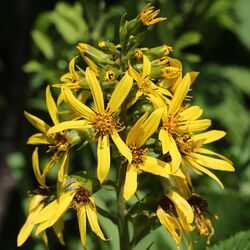Biology:Ligularia fischeri
| Ligularia fischeri | |
|---|---|

| |
| Scientific classification | |
| Kingdom: | Plantae |
| Clade: | Tracheophytes |
| Clade: | Angiosperms |
| Clade: | Eudicots |
| Clade: | Asterids |
| Order: | Asterales |
| Family: | Asteraceae |
| Genus: | Ligularia |
| Species: | L. fischeri
|
| Binomial name | |
| Ligularia fischeri (Ledeb.) Turcz.[1]
| |
| Synonyms | |
|
Synonyms
| |
Ligularia fischeri, known as gomchwi,[2] Fischer's ragwort,[2] or Fischer's leopard plant,[3] is a species in the genus Ligularia (family Asteraceae). It is native to east Asia.[3]
Description
Ligularia fischeri is a clump-forming herbaceous perennial and can grow up to 2 m (6 ft 7 in) tall. It has coarsely toothed, kidney-shaped light green basal leaves, up to 40 cm (16 in) across, on long stalks, the stem leaves smaller and on shorter stalks. The in midsummer, it has racemes of up to 75 cm (30 in) long of yellow flowerheads, 5 cm (2 in) across. Later after it has bloomed, it produces a seed capsule, with seeds with downy hairs which are tinged brown or purple.[3]
Culinary use
Korea
In Korean cuisine, the leaves of gomchwi along with other chwinamul varieties are often used as the main ingredient of herbal side dishes called namul. Gomchwi can be eaten pickled as jangajji or kimchi, and eaten fresh as a ssam (wrap) vegetable.
References
- ↑ "Ligularia fischeri (Ledeb.) Turcz.". Royal Botanic Gardens, Kew. http://www.theplantlist.org/tpl1.1/record/gcc-10137.
- ↑ 2.0 2.1 English Names for Korean Native Plants. Pocheon: Korea National Arboretum. 2015. pp. 517. ISBN 978-89-97450-98-5. http://www.forest.go.kr/kna/special/download/English_Names_for_Korean_Native_Plants.pdf. Retrieved 6 December 2016.
- ↑ 3.0 3.1 3.2 "Ligularia fischeri". Royal Horticultural Society. https://www.rhs.org.uk/Plants/19600/Ligularia-fischeri/Details.
External links
Wikidata ☰ Q5759556 entry
 |


